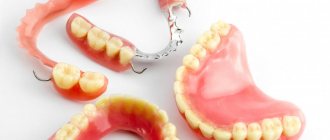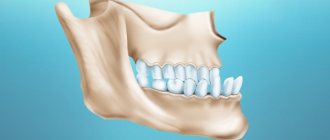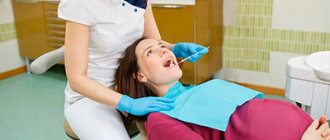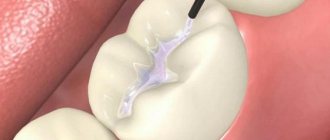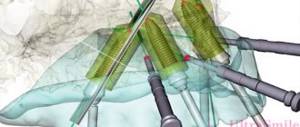Any expectant mother wants her baby to be born healthy. What should you do if your teeth hurt during pregnancy, and there is very little time left before the birth? The pain becomes more and more difficult to bear. Caries eats away at the diseased tooth, leaving it no chance of salvation. In such cases, you cannot do without anesthesia. Many women immediately begin to worry about the question of how harmful anesthesia is for the baby. After all, the doctor advises pregnant women to take even conventional medications with caution, not to mention anesthesia. The article will help you find out what to do if a tooth hurts at 38 weeks of pregnancy, how to treat a sore tooth over a long period of time, what the consequences are for mother and baby, what painkillers are used, and whether it is necessary to treat a sore tooth if the pain can simply be drowned out.
Toothache at 38 weeks of pregnancy
Is it necessary to treat teeth?
It is necessary to take care of your teeth long before you plan to conceive. If there is not enough time to do this, and the test shows two cherished stripes, becoming a pleasant surprise, you will have to not postpone the visit to the dentist until the period when the baby is already born, but immediately take a coupon and go to the doctor.
Important ! An open wound on a tooth is a direct gateway for infection, which is fraught with danger to your health and the health of your unborn baby.
Treatment of teeth in an interesting position will not have a negative impact on its course. Although many women think the opposite and are deeply mistaken.
It's better to take care of your dental health before pregnancy
Pregnancy and teeth: how to treat, care, preserve?
Few human conditions are surrounded by so many myths, prejudices and misconceptions as female pregnancy. As a practicing dental therapist, I want to go through at least those myths that relate to dental health in women preparing for the birth of a child.
Myth 1
: The child takes all the calcium that enters the body, so teeth in pregnant women are destroyed very quickly.
A statement that has no scientific basis. Indeed, the developing fetus requires calcium and many other elements and vitamins, but development certainly does not occur at the expense of the mother’s teeth. The mother’s task in this case is to maintain a proper, balanced diet, with the amount of minerals and vitamins recommended by doctors.
Myth 2
: Taking vitamins is mandatory for all pregnant women.
This is wrong. Taking any medications, including vitamin complexes, is the prerogative of the supervising doctor; any “amateur activity” is inappropriate here. With proper nutrition, the child will have enough of all vitamins and microelements, without taking them additionally in medications.
Myth 3
: Dental treatment during pregnancy should be done without anesthesia - it harms the baby.
Here people often confuse anesthetics with analgesics - and these are fundamentally different drugs. On the one hand, it is very important to monitor the condition of your teeth during pregnancy. On the other hand, the treatment should not harm the fetus. It must be remembered that the best period for dental treatment in pregnant women is the second trimester; that any serious medical intervention must be agreed upon with a gynecologist. And modern dentistry now makes it possible to use anesthetics with an extremely low content of vasoconstrictor drugs or without them at all. Safe pain relief exists, which means there is no need to be a hero and endure pain - this is very harmful.
— Is it possible to get braces during pregnancy?
Myth 4
: Pregnant women should not use braces.
Another misconception. In fact, pregnancy is not on the list of contraindications for installing braces. However, in the first time after installation, pain and discomfort are possible, which may require taking painkillers. But here you need to look at which ones, and with what effect on the development of the fetus.
Myth 5
: It is better not to remove teeth while expecting a child.
But this is largely true. Women carrying children have their teeth removed, including wisdom teeth, only for emergency reasons - for example, for purulent inflammation. Again, after removal, the question may arise about the use of painkillers that can negatively affect the baby’s health.
Myth 6
: It is better to postpone prosthetics and implantation until pregnancy is resolved.
If a woman tolerates pregnancy easily, then dental prosthetics is possible. But implantation during pregnancy is extremely undesirable, like any other type of surgical intervention.
I am also often asked to give recommendations on dental care during pregnancy. I will share them here too.
Firstly, preparing the oral cavity for pregnancy should begin no later than a year in advance. It is necessary to cure all active foci of chronic infection - caries, pulpitis, periodontitis, gingivitis. If required, install implants and perform prosthetics.
Secondly, dental health must be maintained by all means. This means that you need to limit your consumption of sweets and soda, and it is better to replace fruit juices with fruit. You need to brush your teeth at least twice a day, you also need to use floss (dental floss), mouth rinses, and, if you have one, an irrigator.
The diet must include macro- and microelements, vitamins, proteins, a sufficient amount of vegetables, fruits, dairy products, and fish.
Thirdly, you need to pay attention to bleeding gums. If such symptoms appear, you should contact your dentist to prevent complications in the form of periodontitis. And also, taking into account the doctor’s recommendations, balance your diet: eat more carrots, pears, apples, eat less sweet and refined foods, and observe personal hygiene standards.
If for some reason a woman cannot get an appointment with a dentist, and bleeding has already begun, it is recommended to make oral baths with chamomile infusion - they are safe for the development of the fetus.
Dentist-therapist at the Denta Lux clinic Vera Polorotova
therapist at the Denta Lux clinic Vera Polorotova12:27, April 25, 2019
Back forward
The need to treat diseased teeth
Caries is very harmful to the health of the unborn baby - it poses a serious danger to his life. Scientists have long proven the influence of cariogenic bacteria on pregnancy. There are often cases when childbirth due to untreated caries began long before the expected date. The child was born with low birth weight and premature.
This happens due to the harmful activity of bacteria. They are capable of producing anti-inflammatory cytokines in the body of a pregnant woman. The uterus begins to rapidly contract, and the cervical canal begins to open. The membranes cannot stand it and they rupture. Labor begins.
Caries and other dental pathologies can adversely affect the health of the fetus
An infection from the mother's oral cavity can go beyond its boundaries and penetrate other nearby organs and systems of the body.
Important ! Quite often this phenomenon occurs with pulpitis and periodontitis.
In addition, toothache keeps the expectant mother in terrible tension, thereby having a negative impact on her psycho-emotional background. Hormones in this state are rapidly released, including adrenaline, which directly affects the fetus.
It is unlikely that after giving birth a woman will have a free minute and the desire to rush to the doctors. Usually at first there is no strength left for anything. A newborn needs constant care and the presence of the mother nearby. There is no time for treating problem teeth.
After giving birth, a woman will hardly have time to visit the dentist
By playing with the baby or even licking the baby's pacifier or cutlery, a mother with untreated caries can easily infect the baby. It will be convenient for bacteria to “spread” to a body that has not yet become stronger. Staphylococcus always goes side by side with caries. The baby will not be able to avoid serious illnesses, and all because of the mother’s negligent attitude towards her health during pregnancy.
You need to treat your teeth - you can’t do without it. It is worth putting aside fears that the therapy process falls during such a crucial period as pregnancy.
Video - Dental treatment during pregnancy
The most common myths about dental treatment during pregnancy
Myth 1: Dental treatment during pregnancy has a negative effect on the development of pregnancy.
In fact, the fight against dental pathologies in pregnant women not only does not cause harm, but also helps expectant mothers to significantly reduce the risk of complications. For example, timely detection and treatment of caries allows you to save affected teeth, avoid the development of pulpitis and eliminate sources of constant infection from the body of a pregnant woman. Dentists note that all modern materials used in dental treatment are absolutely harmless and do not have a negative effect on the baby’s body.
Myth 2: Expectant mothers can undergo any dental procedure.
This statement categorically does not correspond to reality and is the opposite extreme to the complete ban on dental treatment during pregnancy. There are several procedures that expectant mothers are advised to avoid (for example, whitening, dental implants, dental treatment using drugs containing arsenic or epinephrine).
Myth 3: Pregnant women are prohibited from having their teeth treated under anesthesia.
Indeed, anesthetics of the previous generation were prohibited from being used to treat pregnant women, since some of their components could enter the bloodstream, penetrate the placental barrier and have a negative effect on the development of the embryo. Modern drugs used in dentistry for local anesthesia have a local effect and do not harm the fetus.
Myth 4: Pregnant women should not have x-rays.
It is known that X-ray radiation, as such, has a negative effect on intrauterine development and fetal growth. However, in modern dental practice, filmless devices (radiovisiographs) are used to produce X-rays, which produce radiation with a power that does not exceed a ninth of the threshold. In addition, X-rays are sent directly to the tooth root, which is located at a sufficient distance from the fetus.
It is worth noting that new generation film equipment can also be used to take dental X-rays of pregnant women. At the same time, the patient’s reproductive organs and the developing fetus are protected from harmful radiation using a special lead apron.
Myth 5: the destructive effect on a pregnant woman’s teeth is so great that it is useless to fight the development of dental diseases during pregnancy.
This statement is completely false. With proper oral care and timely treatment, teeth can be kept healthy and beautiful even during pregnancy. To do this, you just need to regularly visit the dentist, follow all medical recommendations regarding dental care, and replenish your diet with foods rich in phosphorus and calcium.
What are the treatment times?
As soon as a problem with teeth arises, the question of when is the best time to see a doctor and what is the most appropriate time begins to swirl in the head of any expectant mother. The first trimester is the most important of all stages of pregnancy. Many people think that it is better to postpone treatment to the next trimesters, but is this right?
It is better not to have dental treatment in the first trimester of pregnancy.
Gynecologists are 100% sure of this, believing that the third trimester is most suitable for treating the problem area of the tooth, but there are exceptions.
Important ! At this time, it is highly undesirable to allow any medications to be taken. Only in extreme cases will the doctor prescribe treatment with them. This applies to diseases such as pulpitis and periodontitis. They entail the spread of infection, and this cannot be allowed.
Other diseases may “suffer” until the next trimester. At twenty weeks, a pregnant woman is scheduled for a routine examination, which includes a trip to the dentist. In the last weeks, you need to be more careful not to expose a woman who is already stressed in connection with the upcoming birth to unnecessary stress.
In the early stages, teeth are rarely treated
Basic recommendations for dental treatment during pregnancy
Of course, it is better to solve all existing dental problems when planning a child, that is, before the start of pregnancy.
If the need for dental treatment arises during pregnancy, then a pregnant woman visiting a doctor should remember that:
- the most optimal time for dental treatment during pregnancy is the second or third trimester (during this period, the formation of all systems and organs of the baby’s body is completed);
- X-rays of pregnant women's teeth are taken only in situations of extreme necessity;
- It is better to carry out treatment in the afternoon (when the manifestations of toxicosis become less pronounced).
Information about the patient’s pregnancy must be sent to the doctor before treatment begins. This allows the dentist to create the most optimal, gentle therapy program using safe medications and helps the expectant mother avoid the undesirable consequences of the procedures.
What means can be used?
First of all, when choosing treatment tactics for a pregnant woman, the following factors will be taken into account: the weight of the woman in labor, how far along she is, what her blood pressure is, concomitant diseases, the nature of the pregnancy.
Important ! If you do not want to harm yourself, then do not self-medicate.
Not all painkillers can be taken at this time. It is best to contact your doctor and consult about pain medication or immediately consult a dentist. This is the best option.
It is better for a pregnant woman not to self-medicate
Pregnancy dates and treatment
The second trimester of pregnancy is more favorable for dental therapy. At this time it is possible to carry out treatment in full. But if it is necessary at other times, then it is carried out, taking into account certain possible consequences:
- For a period of 1-12 weeks, medications can have a negative effect on the development of the embryo;
- 13-24 weeks is the optimal period for dental treatment. This is explained by the fact that after the 14th week of pregnancy the placental barrier completes its formation. By this time, the main organs of the fetus have matured and the risk of uterine tone is minimal.
- 25-40 weeks, a period when a woman should not experience physical and emotional stress, so dental interventions are not recommended. In the last trimester, the fetus puts pressure on the internal organs and the aorta. When being treated by a dentist, a woman should sit in a chair in a special way - on her left side. This is necessary to prevent a drop in blood pressure and the development of fainting.
One of the important issues of dental therapy for pregnant women is the use of anesthesia. It is required when carrying out certain procedures:
- Treatment of medium and deep caries;
- Treatment of pulp hyperemia;
- Tooth extraction (for urgent indications);
- Surgical interventions on soft tissues of the oral cavity;
- Treatment of pulpitis and periodontitis.
When choosing an anesthetic, an important criterion is its permeability through the placental barrier. Therefore, conventional anesthetics are not suitable because they do not meet this criterion. In such cases, specially developed anesthetic substances that do not penetrate the placenta are used. General anesthesia is also not suitable for treatment.
Anesthesia
It is difficult to select medications for pregnant women during treatment. The doctor is limited in his choice. Anesthesia is most often used in dental treatment. However, there are no drugs that do not have side effects.
There is no need to panic ahead of time. Anesthesia can be used for pregnant women. Thus, you will save yourself from constant pain and stop being afraid. If anesthesia is not used, the pain can cause a surge of adrenaline, which can harm the baby and lead to premature birth or miscarriage.
Anesthesia is not too dangerous for both the expectant mother and the child
When choosing the appropriate method of pain relief, the doctor will definitely take into account all the nuances. He needs to obtain information regarding the exact duration of pregnancy. This is necessary in order to choose a more gentle treatment technique.
Important ! Drugs used during the treatment of diseased teeth in pregnant women are selected exclusively for local action. They have minimal impact on the condition of blood vessels.
The most commonly used medications are:
- "Ubistezin";
- "Ultracaine";
- "Primakaine";
- "Septanest";
- "Scandonest".
"Scandonest"
The doctor will select the most suitable one and take into account all the nuances of the patient’s health condition.
You cannot do without a painkiller injection, but it will relieve pain and fear. It is better to be patient once and treat a diseased tooth than to later allow caries to develop into pulpitis, which can subsequently cause sepsis to develop.
It’s better not to refuse a painkiller injection
Cost of dental treatment
| Code no. | NAME OF PROCEDURES | Unit of measurement | Cost, rub. |
| 303 | Medium caries (US, cavity formation) | 700,00 | |
| 304 | Deep caries (ultrasound, cavity formation) | 900,00 |
* The prices indicated on the website are not a public offer. The exact cost can only be determined by visiting a doctor.
Prices for treatment in Moscow full price list
Share on social media networks:
Why are painkillers dangerous?
The path of any painkiller begins with its entry into the gastrointestinal tract, then into the blood. In the blood it is divided into tiny particles. This is necessary in order to silence the nerve receptors and relieve the patient from pain during medical procedures.
It is not difficult for an analgesic to overcome the placental barrier, entering the bloodstream and poisoning the baby’s organs. This is fraught with the following consequences:
- intrauterine development may be impaired;
- sudden surges in pressure. Both mother and child will suffer;
- failure of the liver, kidneys;
- the appearance of gestosis;
- swelling;
- gastritis and ulcers will worsen;
- gastrointestinal irritation.
Lidocaine, for example, is rarely used in the treatment of pregnant women. He will quickly “get close” to the child. This is clearly stated in the annotation. In those rare cases when it is still used in practice, this is done no earlier than 16 weeks. By this time, the placenta is already fully formed.
Lidocaine is not used for pregnant women
“Novocaine”, like “Lidocaine”, is not used in the treatment of diseased teeth in pregnant women - only for medical reasons.
The popularity of using arsenic in the treatment of problematic teeth in pregnant women has declined. Nowadays, people turn to his help less and less. This substance can cause great harm to the body.
The high necrotic effect of the drug kills the nerve endings of the dental canals. Thanks to this, the doctor can safely clean the canals from any infection that has entered them and apply filling material.
The use of drugs with arsenic for pregnant women is undesirable. In rare cases, when a pregnant woman has an individual intolerance to anesthetics, arsenic is still prescribed. After putting the medicine in, a woman should follow some rules. One of them is not to eat solid food. Accidentally getting a hard piece of food onto a filled tooth can cause the filling to fall out and the medicine to leak to the surface.
Important ! If, however, the arsenic paste leaks out, you should immediately visit the dentist. Its release can cause severe pain. This is the result of necrosis of the gum tissue adjacent to the tooth.
Arsenic is rarely placed in the tooth of a pregnant woman
It is important to monitor the time the paste remains in the tooth. If you were unable to meet the appointed time and remove the paste, you will have to go to the dentist and ask for help in carrying out this procedure.
If you have any discomfort from the moment the paste entered your mouth, do not hesitate to tell your doctor about it. He will tell you what to do in such cases.
It is easy to understand that the paste has come out. It is recognizable by its characteristic sour taste. To alleviate the condition before visiting the doctor, you can try rinsing. Soda, for example, neutralizes the effect of arsenic and prevents burns of mucous membranes. Saliva must be spat out.
You can prevent arsenic poisoning, if it still manages to get into the gastrointestinal tract with saliva, with milk. Thanks to this drink, arsenic will be neutralized and its salts will leave the body. There is no need to swallow liters of milk; one glass will be enough.
To neutralize the effects of arsenic, it is recommended to drink milk
If the dose of the drug that enters the body is large, then the accumulation of poisons in the gums and tooth tissues begins. If the tooth canal is poorly cleaned from the toothpaste, inflammation may occur in the periodontal tissues. They can pursue a person for the rest of his life, periodically making themselves known.
Important ! In the first trimester, the use of arsenic in treatment is prohibited. It can lead to disruption of the normal development of the fetus.
If you heard at a doctor’s appointment that you should apply arsenic to the inflamed area, this does not mean that you will actually be prescribed this drug. Instead, completely different agents can be used, the effect of which is similar to arsenic, but in the composition of the medicine it will be in a microscopic dose.
Freezing embryos - a new level of ART
What your IVF protocol will be like is always yours. But having scientific knowledge, we are obliged to share with you. How can IVF be simplified and done with minimal costs and greater benefits? The answer is embryo freezing and cryotransfer. For a long time, there have been debates in the scientific community about freezing and, now, the verdict has been reached - freezing embryos and cryotransfer, which is possible thanks to this technology, makes pregnancy after IVF safer, and the protocol itself more effective.
What is the freezing protocol?
You go through a standard protocol that produces a certain number of embryos. Embryologists select one embryo for transfer in the current protocol, and the remaining strong embryos are frozen. If you need a second try, you simply come for cryotransfer.
How does freezing occur?
The embryo is frozen in liquid nitrogen at a temperature of –196 degrees, previously placed in a special solution - a cryoprotector. The solution protects the embryo and removes excess water, which prevents the formation of crystals that can damage the embryo.
Freezing occurs at a fantastic speed - 25,000 C˚/min, this method is called vitrification
. Frozen embryos will be carefully stored in a Dewar flask and await cryotransfer.
When defrosting, specialists immediately remove the embryo from the cryoprotector that protected it, again, to avoid crystallization. This is a complex but proven mechanism.
How many embryos to freeze?
The embryo is frozen in a straw. This straw is completely unique: it is non-toxic to the embryo, can withstand freezing temperatures and carefully protects the embryo.
The straw can hold one or two embryos. Freezing recommendations are provided for each age category of women.
We offer three options for freezing embryos:
For women under 36 years of age, it is recommended to freeze in the case of the first fresh transfer of one embryo (1 embryo is transferred immediately, the rest are frozen)
1 – 2 – 2 – 2 (1 – one embryo in a straw, 2 – 2 embryos in straw).
This scheme is offered to women under 36 years of age, since the first two protocols recommend transferring one embryo at a time (if there are no other contraindications). For women under 36 years of age, in the case of a delayed transfer, it is recommended to freeze:
1 – 1 – 2 – 2 –2 In the case of a deferred transfer, for women under 36 years of age, the rule of transferring one embryo in the first two protocols also applies.
Women over 36 years old are recommended to freeze two embryos in a straw:
2 – 2 – 2 – 2 – 2
Also, if patients put safety first and insist on transferring only one embryo
in each protocol, the option of freezing each embryo in a separate straw is proposed: 1 – 1 – 1 – 1 – 1
Advantages of the cryoprotocol
There are two options for the cryoprotocol: with stimulation of the endometrium with estrogen and without stimulation in the natural cycle.
Stimulation is needed for women with irregular cycles or in cases where an accidental shift in the cycle is unacceptable, for example, if a woman came for the protocol from another city and cannot wait for the next ovulation. Here we save the patient’s time and money. But if a woman has every opportunity to undergo cryopreservation in a natural cycle, the chance will be used. After the protocol at the EC, pregnancy does not require any support, because there is no effect of hormones.
In any case, the effect on the body during cryotransfer is minimal.
Cryotransfer also allows us to comply with the precious rule: one embryo is transferred per protocol, and we avoid multiple pregnancies. In other words, cryotransfer helps doctors create a healthy singleton pregnancy that is natural for the female body.
The main question: What is the survival rate of embryos after thawing? Today – about 95%.
Embryologists have clear, complex instructions for selecting embryos for freezing. The decision is influenced by many factors: the quality of the blastocyst, the reputation of the embryo, what protocol the woman has, what diagnosis, etc. Only an embryologist can make the right decision about which embryo to freeze.
We freeze embryos with a good reputation. They must be strong and promising. If embryologists understand that the embryo will not survive freezing, they do not freeze it.
Chances of pregnancy
With each subsequent transfer, the pregnancy rate increases by approximately 20 percent. This is called the cumulative pregnancy rate, or more simply, the cumulative effect of the protocols. The point is that each subsequent transfer brings us closer to success.
With cryotransfer, this logic is available: it is cheaper than the standard protocol and allows us to transfer one embryo each time.
Safety in the cryology laboratory
Freezing occurs using liquid nitrogen, which only professionals can work with. There are oxygen sensors, they show the gas level. Ventilation in the cryolabratorium is of particular importance, so the air here is clean. No toxic substance can enter the storage facility. To achieve this, thousands of little details are observed. For example, laboratory staff do not even use deodorant, perfume, or creams. The embryo identification system has been followed. It is impossible to confuse them.
Deferred transfer
If your doctor recommends freezing all embryos and doing cryopreservation in the next cycle, then there is a reason for this. No worries. This way, your IVF only becomes safer, and the chances of pregnancy do not decrease. If you had good stimulation and got a lot of eggs, the endometrium should have time to recover before the transfer.
After a high dose of drugs to stimulate ovulation, the ovary secretes a large amount of steroid hormones, which affects pregnancy. Such a pregnancy can occur with unpleasant symptoms: high blood pressure, gestational diabetes, preeclampsia. It’s better not to risk it and transfer the transfer to another cycle.
It’s simple: the resulting embryos are frozen, the woman skips the cycle, during this time the ovaries are restored, one might say they take a break from stimulation, and when the body is ready, after a month, the transfer occurs. There is no threat to pregnancy, hyperstimulation is impossible. And if after the attempt the pregnancy does not occur, we know that we still have frozen embryos. And the next protocol consists only of cryotransfer, without the use of drugs, cheaper and faster.
Relieve toothache yourself without leaving home
You can relieve toothache at home before going to the doctor. To do this, you need to use an old, proven recipe, which contains nothing except water and soda. You need to prepare a solution at the rate of a teaspoon per glass of water and rinse your mouth with it. The water should be warm.
No cold or heat on a sore tooth. If you warm it up, it is possible that suppuration may occur. If, on the contrary, you apply cold, then pulpitis or periodontitis may worsen. And the pain from the cold only intensifies, but does not decrease in any way.
You can get rid of pain yourself by rinsing
Using an x-ray during pregnancy on the area of a diseased tooth
Many pregnant women are often worried when they are prescribed a dental x-ray, believing that this procedure is harmful to the health of the unborn baby. Even doctors themselves are ambivalent about x-rays, arguing among themselves about this, but sometimes you simply cannot do without it. Only an x-ray will help make an accurate diagnosis and monitor the treatment of a diseased tooth.
Don't be afraid of x-rays during pregnancy
There is no need to be afraid of the procedure. X-rays have a directional effect. They act strictly on one area and do not dissipate. During the procedure, the woman will be wearing a special apron - it will protect the body from harmful effects. It is not advisable to use this procedure in the first trimester; it is better to postpone it to the second or third trimester.
Important ! Still, X-rays in themselves are powerful radiation exposure. The fewer such procedures, the better.
Visiography can be considered as an alternative option. It is absolutely safe for the health of the woman and the unborn baby.
Visiography
Pain treatment in the clinic
It's better not to joke with painkillers. Only in a specialized clinic can you get a 100% guarantee that the tooth will no longer bother you. There is all the necessary equipment for this. The diagnosis is absolutely safe, and the most gentle treatment will be selected for pregnant women.
Important ! Any dental clinic has at its disposal visiographs, intraoral cameras, and systems for painless anesthesia procedures.
A specialist will find out the problem. Next, caries treatment will be carried out taking into account the degree of its complications. They will remove the nerve, pulp and the culprit of the pain – the tooth. Attacks of acute pain are relieved by the administration of an anesthetic. After the injection, noticeable relief is immediately felt.
Anesthesia for pregnant women
The dentist will select drugs with immediate action and minimal harm to the pregnant woman’s body. The most popular of them are “Articaine” and “Mepivacaine”. They are absolutely harmless. They begin to act a few minutes after administration. Not poisonous to the fetus.
An injection of such an anesthetic and removal of affected tooth tissue is safer for mother and baby than taking one dose of any analgesic. It will help relieve you of debilitating pain forever and prevent infection from spreading to other organs.
The doctor will administer medications that are not harmful to the fetus
When is removal necessary?
The operation to remove a tooth is simple at first glance, but, nevertheless, it is considered a surgical intervention. Pregnancy is not at all a reason to cancel it. All doctors assure that it is advisable to carry out it in the last weeks. Local anesthesia will be used during removal.
Pregnant women can have teeth removed
In most cases, removing a tooth is a much better option than leaving such a “time bomb” behind. A cyst in a tooth, malignant neoplasms, inflammatory processes, persistent pain, an inflamed nerve, jaw trauma or tooth trauma are reasons for immediate removal. Here the doctor will no longer hesitate and delay the operation to a later period.
Important ! The only tooth that is not touched during pregnancy is the wisdom tooth. It is not removed. Any surgical intervention in relation to them always entails an increase in temperature, a deterioration in the general condition of the expectant mother, and if she suffers, then the child will suffer “to the fullest.”
Causes of dental problems during pregnancy
- change in calcium metabolism. In early toxicosis, accompanied by lack of appetite, nausea, vomiting, there is an insufficient supply of calcium to the body, which affects the lower/upper jaws. The alveolar processes responsible for the formation of the socket lose this element, which leads to inflammation of the periodontal tissue. The pH of saliva, which contains phosphates, decreases, against the background of which the acid-base balance of the oral cavity is transformed, and bacteria rapidly divide, causing the formation of carious cavities. A sharp failure of mineral metabolism weakens organs, they begin to crumble and become fragile;
- deterioration of immunological status. An increase in the concentration of mucosal hormones changes the barrier characteristics of the epithelium, which leads to an increase in clinical symptoms of gingivitis - bleeding, pain, swelling of the gums, and mobility of the gums. Caries takes on an extremely aggressive course: the disease is detected in 38-40% of expectant mothers, with late toxicosis the rate increases to 90%;
- poor nutrition. A diet rich in carbohydrates and a deficiency of vitamins provoke destabilization of PH. “Metabolic explosion” concentrates on the units and tongue, provokes oxidation of saliva. As a result, the functionality of the salivary glands is significantly reduced, which worsens the hygienic condition, aggravating the clinical picture of periodontal inflammation, increasing the risk of developing complicated caries.
Third trimester. Features of therapy
Treatment in the last weeks is the safest. The fetus is already formed and is under reliable protection of the placenta from external factors. Although the pregnant woman herself feels unwell these days, experiencing a constant feeling of fatigue and anxiety. The woman is worried, experiencing a feeling of incomprehensible anxiety. Any outside interference stresses her out even more.
Not every period is suitable for dental treatment
Treatment is carried out with the patient lying on her back, which causes more pressure on the fetus. The aorta and inferior vena cava are affected. This is not very beneficial for mother and child. The heart beats faster, a drop in pressure is observed, and cardiac output decreases. These factors can lead to a fainting state in the parturient woman. The supine position in the second trimester in rare cases can cause fetal hypoxia.
In the table below we will consider what time for dental treatment in the third trimester is most suitable.
| Period | Description |
| 28-29 weeks | At this time, it is better to refrain from dental treatment. |
| 30-33 weeks | The most favorable period for visiting the dentist to treat dental problems, because the fetus is almost completely formed. |
| 34-37 weeks | Treatment during this period may be a provoking factor for the onset of premature labor, therefore, unless absolutely necessary, it is better not to consult a doctor for therapy. |
| Week 38 | Very dangerous for medical procedures. The uterus at this stage is too sensitive to external influences. Treatment is carried out only after permission from the gynecologist. |
| 39-40 weeks | It is recommended to refuse treatment so as not to provoke premature birth, which can be caused by a woman’s nervous tension or the use of certain medications. |
It is best to do dental treatment at 30-33 weeks of pregnancy
If dental treatment in the third trimester cannot be avoided in any way, when the patient suffers from constant pain due to complications after caries, purulent abscesses, then the pregnant woman must be placed on a chair so that the fetal pressure on the aorta and inferior vena cava is reduced. She should not recline in a chair, but take a position, turning slightly on her side, to the left side.
Prevention of dental diseases during pregnancy
To avoid serious problems with teeth and gums during pregnancy, it is worth following recommendations for oral care, starting from the day the woman learned about her “interesting situation”:
- brush your teeth at least twice a day, and preferably after every meal;
- use dental floss, rinse your mouth thoroughly, you can use antiseptic solutions with the addition of chamomile extract (safe for pregnant women);
- perform professional sanitation in the clinic;
- saturate your diet with foods high in calcium;
- take vitamins recommended by your gynecologist.
Calcium is a “building element” for fetal bones. If it is not enough in the mother's body during pregnancy, it is taken from bones and teeth. To prevent their destruction, you should regularly replenish calcium reserves with proper nutrition and intake of complexes of vitamins and microelements.
If you had dental problems before pregnancy, you need to monitor them especially carefully during pregnancy, remembering to visit the dentist at least twice during the entire pregnancy.
Some useful tips
Most women, who are in joyful anticipation of the birth of a baby, try by any possible means to delay a visit to the dentist, believing that dental treatment using anesthesia will harm the unborn child. It is not right. It is necessary to treat your teeth. Delaying time can make the situation worse.
Important ! Caries promotes the spread of infection. Toxins begin to travel throughout the body through the digestive tract. Blood flows carry them even further, to other organs and tissues. Through the umbilical cord, dangerous substances reach the embryo.
Don't delay dental treatment
The expectant mother's diseased teeth threaten her with toxicosis in the later stages. It is advisable to play it safe and avoid such situations. To do this, long before pregnancy, you need to carefully monitor the condition of your teeth and visit the dentist at least once a year. During the examination, he will immediately notice the beginning changes in the tooth, and if necessary, he will place a filling. Even if it seems to you that your teeth are in perfect order, this is not a reason to put off visiting the doctor. This way you can avoid complications in the future, and they will certainly arise if you neglect this advice. If a tooth does get sick during pregnancy, if you seek help in a timely manner, the problem will be solved as soon as possible.
Embryo transfer after cryopreservation
If the embryo has undergone cryopreservation at the crushing stage (2, 4, 8 cells), the doctor can carry out replanting immediately after defrosting. In cases where freezing was carried out at the stage of two pronuclei, the physician monitors the condition of the embryos for several days. After making sure that they are developing normally, the doctor performs a replantation. The use of cryopreserved embryos does not reduce the likelihood of pregnancy. When performing in vitro fertilization after cryotransfer, the chance of getting pregnant is approximately 30%. It is worth noting that infectious diseases suffered by a woman before the procedure reduce the chances of becoming pregnant. The body must recover before undergoing such a procedure.
If the doctor chooses a natural protocol for transferring embryos after defrosting, the transfer is carried out during ovulation. The stimulated protocol is characterized by the fact that ovulation is induced in the patient using hormonal drugs. The doctor selects the protocol taking into account the reproductive characteristics of the woman’s body. After the transplantation, she must remain in bed for several days, avoid physical exertion and psychological shocks. Also, after this procedure, you must follow the recommendations of your doctor regarding the dosage of hormonal medications.



